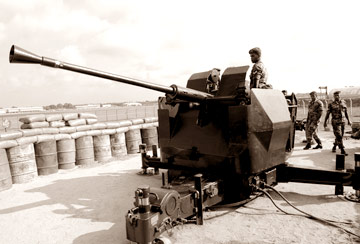|
Air Defence System:
Mechanism that saved a thousand lives
By Dhaneshi YATAWARA
|

Anti - aircraft gun
|
The Sri Lankan air defence system has a short history of only two
years. Set up at the end of 2006 Sri Lanka Air Force's Air Defence
System is a combination of different security networks. Following the
successful mission of destroying the two LTTE suicide aircraft on
February 20, an expert group of the SLAF speaks about the Air Defence
System and its role. Following are some excerpts of the interview. Names
of the Air Force officers cannot be given due to security reasons.
Q: What is the Air Defence System?
A: It is a system which is designed to defend a country from possible
air attacks. It is called a ground to air attack system. Which is
capable of detecting identifying intercepting and then destroying the
enemy craft. It is a complex and vital network the operation of which is
kept in high security.
Q: How do you account for its efficiency in the Sri Lanka's
context?
A: We established the system at the end of 2006. But actually the
concept was mooted in 2005 when the present Air Force Commander was the
then Operations Director. Hence, our political leadership had a very
good understanding of importance of the system to the country. The
present system covers the entire sky area of the country. Within the two
years the system was improved at a greater speed. In any country for
such a system to adjust to its security requirements. It will take even
twenty years perhaps. But, here we managed to meet the challenge just in
two years.
Q: Does the system cover the entire country?
A: Yes, it does. The system has two aspects - the equipment and its
human resource dimension. Both are equally important to us. But this is
a highly advanced system. We have five radar points located in all four
directions of the country and we receive intelligence information from
the service personnel connected to the system. The system doesn't work
on machines alone. We act in close cooperation with the Sri Lanka Army,
Navy and the Police as well. This is a team work.
Q: Do you mean to say the system is adequate to secure the
country?
A: Yes, it is. When we identify that a threat to the country is
loosing we inform the relevant police stations through Police
Headquarters and they take the necessary action to switch off the lights
in the area and they inform the civilians of the area. Basically they
assist us to get ready with defence precautions. This preparation comes
only in its last stage. The first step would be either the intelligence
information we receive through our human network or detecting the
unidentified aircraft in the radar system. Then with the information and
the data, we identify the aircraft. And it's a complicated method
identifying the aircraft. But it can be done in few minutes. The next
step would be interception and last would be attack and destroy if we
confirm that the aircraft is a threat. We have placed the anti aircraft
guns in selected locations in the country.
Q: If so why couldn't the system destroy the LTTE aircrafts during
the previous air raids?
A: This threat from the LTTE is unique in the local context. There is
no specific set up for these systems in the world.
The method we should adopt depends on the nature of the threat. As I
mentioned earlier, the time available was very much limited for us to
gather any experience. We couldn't find similar situations previously
experienced by another country.
The success we had on February 20 was a result of perseverance and
commitment to the purpose. Now we are on a firm ground. Even before, the
LTTE could not reach its targets.
They were compelled to divert because of the preparedness of the Air
Defence System. They just dropped bombs at random. Those could never
impose any positive impact on the security of the country.
Q: Certain sections of the public were critical that you allowed
the two LTTE aircraft to reach Colombo. What is your comment?
A: No, we don't wait until they reach their targets. We used our
lined up systems to bring the LTTE aircraft down. But the LTTE knowing
our gun emplacements can avoid those. We can monitor the aircraft's
movements without losing a single second! No sooner the aircraft enters
the firing range of anti aircraft guns, we start attacking them. Before
that we get the information and confirm it's an enemy aircraft and
inform the jet squadrons with air to air interception capability to take
off and attack the enemy. These jet squadrons are kept ready round the
clock to meet any urgency.
Q: How would you define the effectiveness of the Air Defence
System?
A: If not for the Air Defence System, the LTTE would have conducted
their air raids as they wished. Because of the active system they feared
to take a chance and attack. Officers and airmen work round the clock
since we can't afford to lose even a second.
Q: How long would this system be effective?
A: We are adding new developments continuously to the system. It is
an unending process! We have to face asymmetric threats in the present
world. Hence, the system can't stop developing its capacities. |


